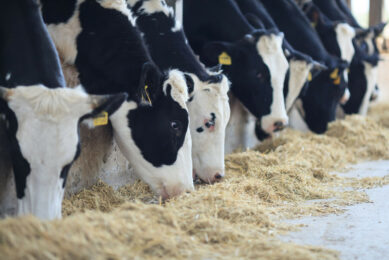Tapping the potential of gut health feed additives

If feed additive produces truly want to add value to animal production, they should offer optimal solutions to their customers, rather than just selling them active ingredients. This can only be achieved by continuously evaluating new scientific insights, as well as implementing feedback from the field.
Over the last few years, feed additives that support gut health have gained special attention from animal producers worldwide. It is now widely recognised that these products can contribute to animal health and farmer profitability. Especially during the last decade, in many regions interest has been further nourished by regulatory ambitions to restrict the use of antibiotics, either as antimicrobial growth promoter (AGP) or as veterinary drugs.
The childhood of gut health additives
Consequently, this trend has instigated further growth of the feed supplements’ market that strengthen intestinal health and function. Since their introduction, additive producers, feed mills and farmers have gained knowledge about these additives, often by trial and error. For some, that may have come down to adjusting unrealistic expectations, while for others, certain applications have been implemented with great success.
In those early days of gut health promoting products, success was often dependent on the selection of certain active ingredients (such as butyrates, botanicals and yeast cell walls to only name a few) and empirical evidence that they indeed could improve animal performance. Often, when trying to explain these effects, references were made to in vitro studies hinting to villi length measurements or to putative underlying modes of action, and that was that.
Shifting to the next gear
It might seem tempting for feed additive producers to rest on their laurels: active substances have been identified, and their modes of action have partially been explained. If you allow me to exaggerate a bit: why wouldn’t they just keep an eye on recently published scientific literature to check whether another molecular mechanism can be linked to their products, and show off with that knowledge at the next conference?
Instead, I would argue that in times like these, feed additive companies should profit from the wealth of input they receive, both from scientific studies, as well as from feedback of their customers. Even if that means that some older ideas need to be revised.
Getting the most out of the potential
Although screenings to identify novel active substances that can be applied as novel feed additives will always be of interest, experiences of the past suggest that it is unlikely that anytime soon, a ‘super additive’ will be discovered, which will outperform and replace all other additives. Rather, I would argue that more can be gained by focusing on maximising the efficacy and robustness of existing active ingredients that improve gut health.
Indeed, several classes of molecules have demonstrated to at least have the potential to claim a place in programmes aiming to improve animal health and performance. However, how much of that potential is realised when these molecules end up in the animal’s intestinal tract, depends on the time and energy feed additive companies have invested in optimising these ingredients.

From theory to reality
Butyrate, for instance, has been described to be able to activate myriad of cellular signalling pathways, along the entire digestive system, as well as in extra-intestinal tissues. But, which part of these butyrate-dependent responses are triggered, depends very much on where this short-chain fatty acid is delivered inside the animals: unprotected butyrate, butyrate glycerides and coated butyrates have very distinctive butyrate release profiles in vivo. And even in the group of coated products, a wide variation of gastric bypass characteristics can be observed. Discussing the release profile of a butyrate product with customers is therefore critical when trying to offer a solution that addresses specific needs and expectations.
Another example are yeast cell walls (YCW). These are a source of glucan and mannanoligosaccharides (MOS), which have described to modulate the activity of immune cells and to inhibit the villi binding of certain (pathogenic) bacteria, respectively. Understandably, many suppliers have opted to offer YCW with a high content of glucan and MOS, thinking this would guarantee optimal performance of the product. However, when we explored the capacity of YCW to trigger immune responses in vitro and in vivo, though, we found that there was no correlation between their levels of glucan or MOS content, and their biological activity. Instead, additional analyses were needed to better predict the immune-related responses of YCW.
Setting up programmes
Once each active ingredient is turned into a product with maximum potential, we can look at whether they can be combined to widen their effect. However, mixing ingredients to create a ‘broad-spectrum’ product seems a logical upgrade, but it comes with some pitfalls as well.
For example, blends of several ingredients aren’t necessarily better than single component products. In fact, although ingredients are easily said to be ‘synergistic’, evidence should be presented that there is at least an additive effect. Indeed, the risk is high that, by definition, the amount of the most effective ingredient is just diluted by the other components. Or to put it differently: if you can choose between 1kg of gold and 1kg of a mixture of gold, silver and iron, you better pick the first one!
Moreover, as the challenges and needs of animals change during their production cycle, tailor-made solutions can often better be achieved by setting up a programme with different additives for distinct stages, rather than making a blend that is supplemented to the feed from starter to finisher.
Listening to customers
Last but not least, any advice on products, whether it is about inclusion levels, combination programs or any other aspect of their application, should start from a sound scientific basis. But if you want to take it to the next step, and offer practical solutions, it is equally important to realise that this theoretical basis should be complemented with local field knowledge.
Animal rearing conditions, together with regulatory and economic contexts, feed production etc: they all will vary from region to region. And feed mills and farmers will most likely have already tried out several dietary interventions to improve gut health, so they have built up experience and expertise of what works in their situation, and what not. These insights will be vital in a discussion on implementing best practices.
Moreover, while exchanging knowledge, new ideas can pop up unexpectedly. For example, one customer told me that he could significantly reduce oviduct inflammation in his broiler breeders using one of our gut health products. Now, although one could theorise how some substances can be absorbed and exert an extra-intestinal effect, I was always reluctant to the idea that feed additives could have such an impact on the reproductive system. But now that a number of customers in different parts of the world are reporting the same finding, it’s for sure something I will further investigate.
Future gut health feed supplements looks bright
With opportunities to have a strong impact on animal performance and customer profitability, the future for gut health related feed supplements looks bright. Especially if additive producers keep an eye on basic research and use that knowledge to get the most out of a beneficial substance. In addition, they have to engage in 2-way conversations with customers. Only then will they be able to offer the best practical solutions.











